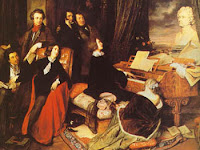 This weekend's Heroine is Matilda Gage, suffragist, Native America rights activist, abolitionist and author, who died on March 18, 1898. She's not as well-known as some of the early suffragists, but was a tireless worker for human rights.
This weekend's Heroine is Matilda Gage, suffragist, Native America rights activist, abolitionist and author, who died on March 18, 1898. She's not as well-known as some of the early suffragists, but was a tireless worker for human rights.Matilda was born March 24, 1826, the daughter of abolitionist Hezekiah Joslyn, and grew up in a house that was a stop on the Underground Railroad, which established her concern for the rights of others. She lived most of her life in Fayettesville, New York, eventually marrying Henry Gage and having 5 children with him (one of her daughters, Maud, married Wizard of Oz author L. Frank Baum).
Her women's rights career was launched when she spoke at the National Women's Rights Convention at Syracuse, NY in 1852 and joined forces with Elizabeth Cady Stanton and Susan B. Anthony (though she came to be considered much more radical than them!). She went on to serve as president of the National Women's Suffrage Association 1875-77, holding other positions within the organization for 20 years. Eventually she and her supporters split off into the more extreme Women's National Liberal Union in 1890.
She became a Theosophist, who opposed the Christian church and it's opposition to a change in women's traditional roles, strongly supportingt the separation of church and state (a debate still ongoing) and publishing such works as Woman Church and State to lay out her position. She was the owner and editor of the feminist The National Citizen, and was arrested for attempting to vote in 1871. She supported Victoria Woodhull in the 1872 presidential election.
Matilda Gage died in 1898 of a stroke. She was cremated, but a memorial stone in her family plot is carved with her lifelong motto: "There is a word sweeter than Mother, Home, or Heaven. That word is Liberty."
A couple of sources on her fascinating life:
Sally Roesch Wagner, Matilda Joslyn Gage: She Whol Holds The Sky (1998)
Leila R. Brammer, Excluded from Suffrage History: Matilda Joslyn Gage, 19th Century American Feminist (2000)




